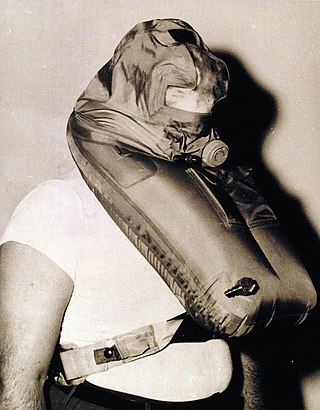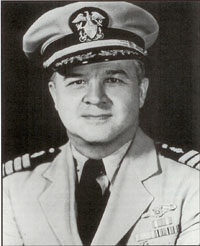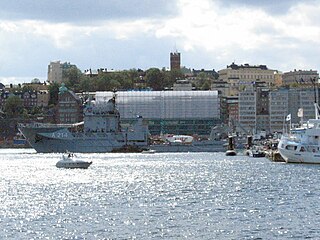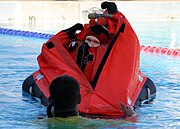
Naval Submarine Base New London is the primary United States Navy East Coast submarine base, also known as the "Home of the Submarine Force." It is located in Groton, Connecticut directly across the Thames River from its namesake city of New London.

A frogman is someone who is trained in scuba diving or swimming underwater in a tactical capacity that includes military, and in some European countries, police work. Such personnel are also known by the more formal names of combat diver, combatant diver, or combat swimmer. The word frogman first arose in the stage name the "Fearless Frogman" of Paul Boyton in the 1870s and later was claimed by John Spence, an enlisted member of the U.S. Navy and member of the OSS Maritime Unit, to have been applied to him while he was training in a green waterproof suit.

A Steinke hood, named for its inventor, Lieutenant Harris Steinke, is a device designed to aid escape from a sunken submarine. In essence, it is an inflatable life jacket with a hood that completely encloses the wearer's head, trapping a bubble of breathable air. It is designed to assist buoyant ascent. An advancement over its predecessor, the Momsen lung, Steinke first invented and tested it in 1961 by escaping from the USS Balao at a depth of 318 ft (97 m); it became standard equipment in all submarines of the United States Navy throughout the Cold War period. The U.S. Navy replaced Steinke hoods on U.S. submarines with escape suits called Submarine Escape Immersion Equipment in the late 2000s.

Charles Bowers Momsen, nicknamed "Swede", was born in Flushing, New York. He was an American pioneer in submarine rescue for the United States Navy, and he invented the underwater escape device later called the "Momsen lung", for which he received the Navy Distinguished Service Medal in 1929. In May 1939, Momsen directed the rescue of the crew of Squalus (SS-192).

Scuba diving is a mode of underwater diving whereby divers use breathing equipment that is completely independent of a surface air supply, and therefore has a limited but variable endurance. The name "scuba", an acronym for "Self-Contained Underwater Breathing Apparatus", was coined by Christian J. Lambertsen in a patent submitted in 1952. Scuba divers carry their own source of breathing gas, usually compressed air, affording them greater independence and movement than surface-supplied divers, and more time underwater than free divers. Although the use of compressed air is common, a gas blend with a higher oxygen content, known as enriched air or nitrox, has become popular due to the reduced nitrogen intake during long or repetitive dives. Also, breathing gas diluted with helium may be used to reduce the likelihood and effects of nitrogen narcosis during deeper dives.
There are three major types of submarines in the United States Navy: ballistic missile submarines, attack submarines, and cruise missile submarines. All submarines currently in the U.S. Navy are nuclear-powered. Ballistic missile submarines have a single strategic mission of carrying nuclear submarine-launched ballistic missiles. Attack submarines have several tactical missions, including sinking ships and subs, launching cruise missiles, and gathering intelligence. Cruise missile submarines perform many of the same missions as attack submarines, but with a focus on their ability to carry and launch larger quantities of cruise missiles than typical attack submarines.

The Momsen lung was a primitive underwater rebreather used before and during World War II by American submariners as emergency escape gear. It was invented by Charles Momsen. Submariners trained with this apparatus in an 80 ft (24 m) deep Escape Training Tank at New London, Mare Island, or Pearl Harbor. It was introduced as standard equipment on Porpoise (P)-class and Salmon-class boats.

An escape trunk is a small compartment on a submarine which provides a means for crew to escape from a downed submarine; it operates on a principle similar to an airlock, in that it allows the transfer of persons or objects between two areas of different pressure.

Escape breathing apparatus, also called escape respirators, escape sets, self-rescuer masks, emergency life saving apparatus (ELSA), and emergency escape breathing devices (EEBD), are portable breathing apparatus that provide the wearer with respiratory protection for a limited period, intended for escape from or through an environment where there is no breathable ambient atmosphere. This includes escape through water and in areas containing harmful gases or fumes or other atmospheres immediately dangerous to life or health (IDLH).

The Naval Submarine Medical Research Laboratory (NSMRL) is located on the New London Submarine Base in Groton, Connecticut. It is a subordinate command of the Naval Medical Research Command.

A Submarine Escape Training Tower is a facility used for training submariners in methods of emergency escape from a disabled submarine underwater. It is a deep tank filled with water with at least one underwater entrance at depth simulating an airlock in a submarine. Since the 1930s, towers have been built for use by the Royal Navy, US Navy, Royal Australian Navy and in several other countries.

The United States Navy Experimental Diving Unit is the primary source of diving and hyperbaric operational guidance for the US Navy. It is located within the Naval Support Activity Panama City in Panama City Beach, Bay County, Florida.

Captain Charles Wesley Shilling was an American physician who was known as a leader in the field of undersea and hyperbaric medicine, research, and education. Shilling was widely recognized as an expert on deep sea diving, naval medicine, radiation biology, and submarine capabilities. In 1939, he was Senior Medical Officer in the rescue of the submarine U.S.S. Squalus.
Survitec Group is a British manufacturer of personal survival equipment for usage after ejecting from aircraft or when at sea.
The Royal Swedish Navy's Submarine Escape and Rescue system (SMER) is a set of equipment used by the Swedish Navy to provide rescue facilities for the crews of disabled submarines. The submarine rescue ship, the submarine rescue vessel, and the escape system on the submarines, which consists of an escape trunk and an escape suit, are its three main parts.

URF is the Royal Swedish Navy’s Submarine Rescue Vessel.

The Royal Navy's Submarine Parachute Assistance Group (SPAG) is a team who provide a rescue support capability to submarine sinking incidents worldwide, available at short notice.

The following outline is provided as an overview of and topical guide to underwater diving:

The following index is provided as an overview of and topical guide to underwater diving:
Submarine rescue is the process of locating a sunk submarine with survivors on board, and bringing the survivors to safety. This may be done by recovering the vessel to the surface first, or by transferring the trapped personnel to a rescue bell or deep-submergence rescue vehicle to bring them to the surface. Submarine rescue may be done at pressures between ambient at depth, and sea level atmospheric pressure, depending on the condition of the distressed vessel and the equipment used for the rescue. Self-rescue of submarine personnel by buoyant free ascent at ambient pressure is considered submarine escape. Survivors may require recompression treatment for decompression illness.


















